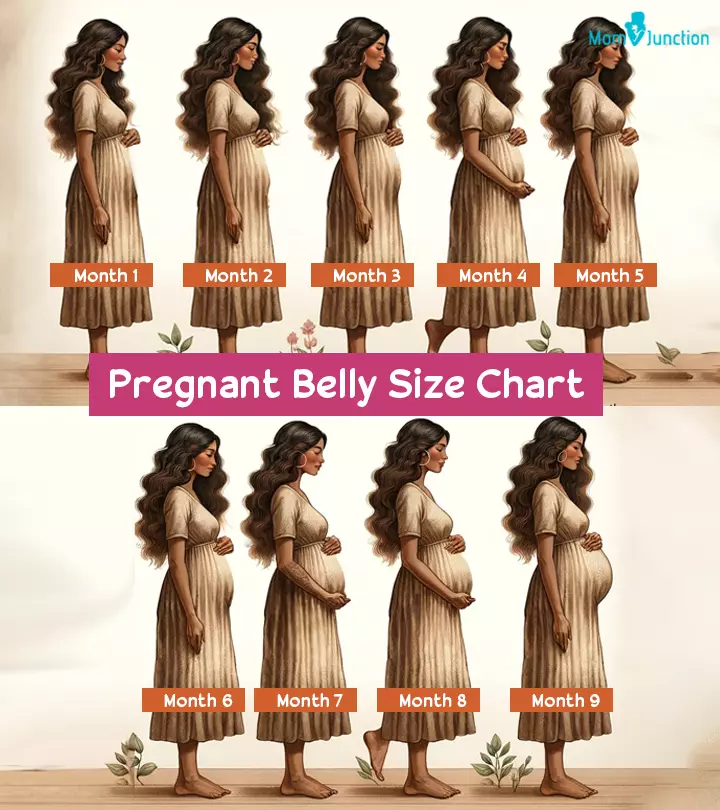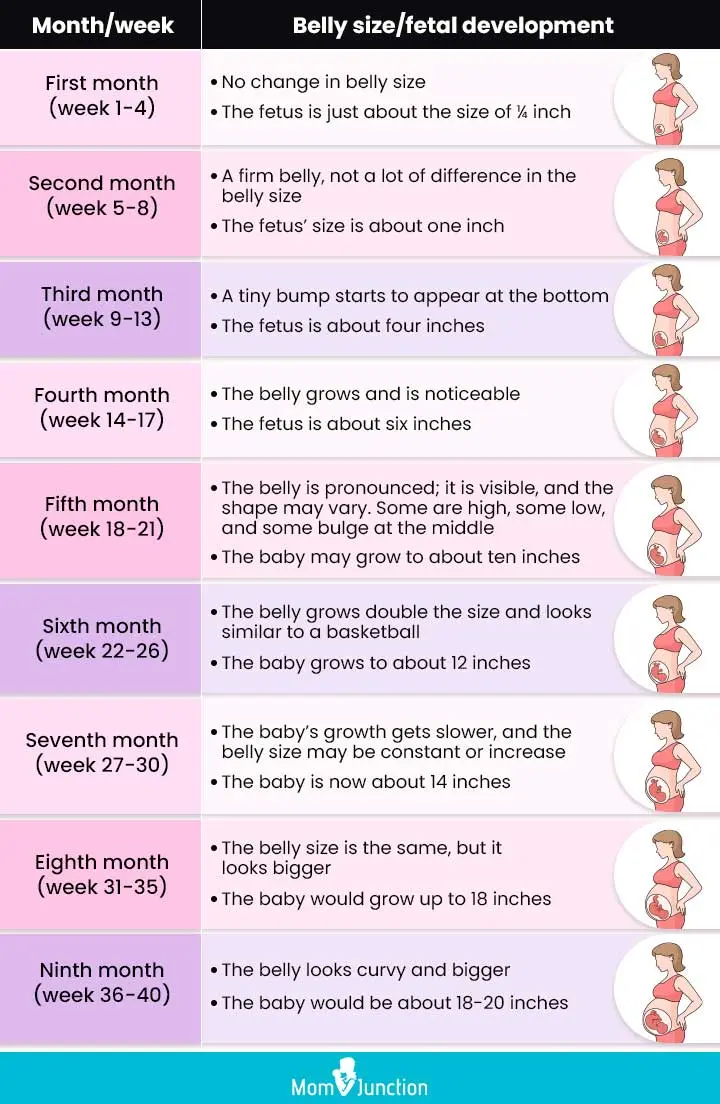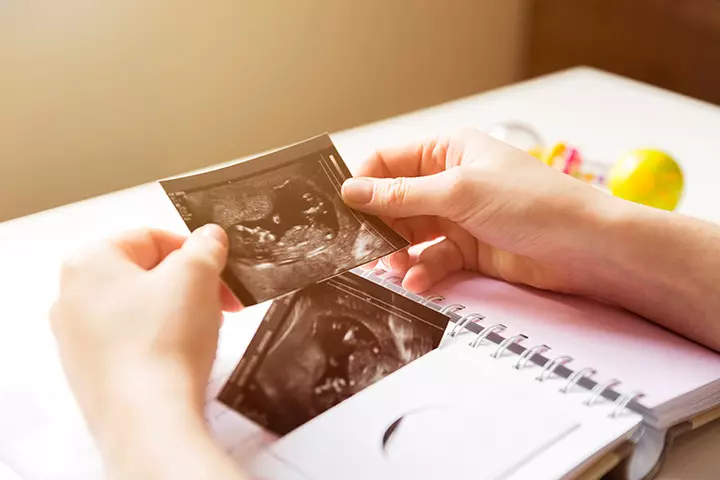
Image: Created with Dall.E
The pregnant belly size chart helps to understand the growth of a baby bump. However, the size and shape of the pregnant belly may vary in each woman. Some may have a comparatively smaller belly for women in the same weeks of gestation. While a few may have larger sizes. Keeping a pregnant belly size chart may help you understand the growth rate of your belly and see if there is a gradual increase or decrease in size.

Read on to know the pregnant belly size chart and identify and manage related concerns.
Key Pointers
- The pregnancy belly size chart is an approximate guide to the changes a woman may experience as the baby grows.
- Every woman’s belly size and shape is unique, and they do not determine the size or gender of the baby.
- Belly size does not indicate the health, gender, or progress of the pregnancy.
- It is not a reliable indicator of the stage of pregnancy.
- Factors that determine the size and shape of the pregnant belly include: first pregnancy or subsequent pregnancy, amniotic fluid volume, change in the baby’s position, mother’s height, and where the mother carries her weight.
Pregnancy Belly Size Chart
This downloadable pregnant belly size chart shows the changes you may notice during your pregnancy week by week in your belly as the baby grows. It also explains fetal development week by week. It is an approximate chart, and the measurements and changes could vary from one woman to another (4).

In case you do not notice the above changes, do not panic or assume something is wrong. Check with the midwife or doctor if you’re worried about the shape or size of the belly.
Does The Belly Size In Pregnancy Really Matter?
The size of your pregnancy belly may not be something of concern. Your belly could be big, small, pointy, round, or high, but that still might not necessarily affect the pregnancy. Some people may try to guess the baby’s gender, health, and progress by looking at your belly, but you should not worry about what anyone other than your obstetric or midwife says.
Does Your Belly Size Determine The Gender And Size Of The Baby?
The belly size and shape determine neither the size nor the gender of the baby. A large belly could be due to excess body weight or amniotic fluid, while a small belly could be due to less amniotic fluid or if it is the first pregnancy. The size of the belly has nothing to do with the gender of the baby.
 Quick fact
Quick factAccording to Stephanie Langsam, MD, FACOG, a board-certified physician specializing in obstetrics and gynecology, “There is no scientific evidence between a girl bump or a boy bump. Just as people’s bodies are different, so are their pregnant bellies.”
Can Belly Size Accurately Indicate Your Stage of Pregnancy?
The size of the belly may not be an indication of the stage of pregnancy. The belly size during different phases of pregnancy differs from one woman to another, based on her body type and size. Regardless of the belly size, ensure that you’re maintaining a healthy weight as being overweight or underweight during pregnancy might affect the growth of the baby (1).
It is best not to compare the size of your bump with that of other pregnant women, as the belly size may depend on several factors.
What Factors Determine Your Belly Size?
The following factors might determine the size and shape of the pregnant belly:
- First pregnancy: If it is your first pregnancy, you may tend to have a more compact bump as the abdominal muscles have not been stretched before. The muscles that hold your baby high feel tighter and more toned. Also, the bump is likely to be smaller than it would be in your second or subsequent pregnancies.
- Second or subsequent pregnancy: The first pregnancy could stretch your abdominal muscles and make it quite flexible. Unless you are into fitness or you are an athlete, your muscles might not regain their original shape or tone back. So, you may notice a bigger bump than before. Again, that does not mean your baby would be bigger.
- Amniotic fluid volume: As per a study by the Kofinas Perinatal and Fertility Institute, the amniotic fluid index keeps changing throughout pregnancy. The average index of the amniotic fluid in a normal pregnancy is more during the second trimester, while it is comparatively less during the third trimester. Based on the production of this fluid, but not your baby’s size, your belly may appear small or big (2).
- Change in the baby’s positions: From the second trimester, the baby might become active and begin to move inside the tummy. This may alter the shape and size of your belly. For instance, your baby might sometimes move from one side to the other, changing the shape of the tummy slightly (3).
And during the last stage of pregnancy, the head generally moves down into the pelvis, making the tummy look bigger at the bottom. This means that the baby’s position may affect the belly size and shape.
Susan Lim, a mother, describes the moment she first felt her baby moving. She says, “I am 15 weeks pregnant, and about four days ago for the first time. I felt our baby, so what happened is I woke up in the morning and I was laying on my back and right away I could feel that there was a big lump in my abdomen. So I felt it and it was like a hard lump and I was pretty sure that was the baby because I’ve never felt anything like that before ever it was just kind of like a ball like like a orange I guess because the baby is supposed to be the size of an orange right now (i).”
- Mother’s height: Taller women have a longer torso, which gives more space for the baby to grow. So, while the baby grows, the belly grows upwards and not outwards. On the other hand, shorter women will have less space, and their baby will push outwards and not upwards.
Dr. Langsam adds, “At each prenatal appointment, your doctor will measure the fundal height. The fundal height is the measurement from the pubic bone to the top of the uterus. This grows about one centimeter per week, and at around 20 weeks of pregnancy, the uterus is at the level of the belly button. Each week, your fundal height should be equal to your gestational age. If the measurement is more than three centimeters off, then a growth ultrasound can help us determine if your baby is too big or too small.”
 Did you know?
Did you know?Common Concerns About The Pregnant Belly
Some of the common concerns that pregnant women might have about their bellies are mentioned here:
- Small belly: If you have a small belly and your doctor or midwife tells you it is normal, then you do not have to worry about it. One of the concerning reasons for a small belly could be oligohydramnios or low amniotic fluid. The condition may be diagnosed through an ultrasound, and the doctor could suggest a treatment based on factors such as its extent and your medical history (5). Some other reasons for having a small pregnant belly include maternal height and weight, first pregnancy, ethnicity, fetal position, fetal size, or a condition known as fetal growth restriction (6).
- Large belly: If your belly is growing quickly, you may visit your doctor for a check-up. Usually, it could be normal due to your previous pregnancy or other factors. One of the concerning reasons for an unusually large belly could be polyhydramnios, or a high amount of amniotic fluid (7), which would be diagnosed by your doctor and handled appropriately.
According to the Fetal Medicine Foundation, polyhydramnios is mild in roughly 80% of the cases, moderate in 15%, and severe in 5%. Proper diagnosis and timely treatment are essential for its proper management and treatment.
- High belly: If you are carrying high, it usually means you have a good muscle tone and strong abdominal muscles. Also, it could be because you’re tall, and in most cases, a high pregnancy belly is considered normal unless diagnosed otherwise by your doctor or midwife. However, make sure your doctor monitors the size of the belly regularly, and performs regular ultrasonography to ensure healthy fetal growth.
- Low belly: With a low belly, it might seem like the baby is ready to come out any minute, but that is not normally the case. Carrying a low belly could cause discomfort, pressure on the lower back, and pelvic pain, but is not a reason for concern.
- Wide belly: Carrying wide usually means that the baby is in a side-to-side position, a situation termed as a transverse lie (10). It could be a problem if the baby does not turn with its head down at the time of labor. However, sometimes, an overweight pregnant woman may carry wide, which is not a reason for concern.
Your pregnancy belly lasts only as long as your pregnancy does. So, celebrate it with special activities.
 Quick Fact
Quick FactCommon Myths About Pregnancy
Here are some common myths about pregnancy, along with factual explanations to debunk them:
- Myth: The shape of the bump reveals the baby’s gender
Fact: It’s commonly thought that a high, round bump means you’re having a girl, while a low, pointed bump suggests a boy. However, the shape of the bump is influenced by factors such as the mother’s physique, muscle structure, and the baby’s positioning, rather than the baby’s gender (8). - Myth: Flying during pregnancy is unsafe
Fact: Flying is typically safe for you and your baby during pregnancy. However, you should consult your doctor or midwife about any health issues or potential complications before planning a trip. - Myth: Exercise isn’t safe during pregnancy.
Fact: Most pregnant women can safely benefit from regular exercise. However, checking with a healthcare provider before beginning any new workout routine is essential. - Myth: Morning sickness only happens in the morning
Fact: Morning sickness isn’t limited to the morning; it can happen at any time of day. It is triggered by hormonal changes and is common among women, particularly in the first trimester (9).
Celebrating Your Pregnancy Belly
Here are some exciting ideas to make your pregnancy memorable:
1. Photoshoot:
A pregnancy photoshoot is a trend these days that lets you capture your journey through motherhood by taking pictures of your pregnancy belly every month and creating a beautiful collage at the end.

2. Belly painting:
Painting something creative and beautiful on your belly is another thoughtful way to celebrate your pregnancy and the beginning of your journey in parenting. You can let your husband or child do it, or get it done professionally.

3. Pregnancy book:
You can create a maternity journal and record anything and everything about your pregnancy. Take pictures of your pregnancy belly every month and paste them in the book. Also, you could write what you are feeling at every stage. Your baby would be happy to read it when he/she grows up.

 Quick tip
Quick tipInfographic: What Factors Determine Belly Size During Pregnancy?
Some thing wrong with infographic shortcode. please verify shortcode syntaxFrequently Asked Questions
1. Why is my pregnant belly small in the morning?
The size of a pregnant woman’s baby bump can change throughout the day. For instance, in the morning, after the food from the previous night has been digested, the baby bump may appear smaller. However, as the day goes on and the stomach gets filled with food, the baby bump may become more prominent.
2. What does it mean if my bump is measuring big?
You may have a big belly for several reasons, such as water retention or excess weight gain due to imbalanced eating. However, a too-large baby bump could be due to high sugar levels (gestational diabetes) during pregnancy. High maternal blood sugar levels can cause the baby to receive excessive sugar and grow larger than usual. Additionally, it can lead to an excess of amniotic fluid (polyhydramnios), which can also cause the belly to appear larger (14).
3. What week is your belly the biggest?
The size of the belly varies from woman to woman, but it is usually at its largest between the 36th to 40th weeks of pregnancy. This varies depending on factors such as the mother’s body type and the position of the baby (4).
4. Are there any risks or concerns associated with measuring pregnant belly size?
Measuring pregnant belly size is generally safe and is often performed at prenatal check-ups. However, depending exclusively on belly size can occasionally lead to apprehensions and incorrect conclusions. It is hence critical to seek the advice of a healthcare expert to address any specific concerns (13).
5. How often should I measure my belly during pregnancy?
The frequency of measuring your belly during pregnancy varies based on your pregnancy health. Usually, the belly is measured at prenatal check-ups, which generally take place at 20 weeks pregnancy and more frequently in the later stages (13) (15).
6. Are there any specific tips or exercises that can help maintain a healthy belly size during pregnancy?
You can maintain a healthy weight and belly size during pregnancy by staying active daily with mild and safe activities such as walking and light aerobic exercises, staying hydrated, and by consuming a balanced diet. It’s essential to consult a healthcare professional for personalized guidance (16).
Enjoy every week of your pregnancy, eat healthy foods, and follow the instructions of your doctor or midwife. Do not pay attention to the folklore surrounding the shape and size of a pregnant woman’s belly. Also, ensure that your doctor or midwife is carefully monitoring fetal growth and belly size.
How was your pregnancy belly? Do share your experiences and what stories you came across about your belly in the comment section below.
Pregnancy is a time of change, and your belly size is no exception. Learn how to tell if your bump is too big or too small in this informative video.
Personal Experience: Source
MomJunction articles include first-hand experiences to provide you with better insights through real-life narratives. Here are the sources of personal accounts referenced in this article.
i. Feeling Baby For The First Time – 15 Weeks Pregnant
https://www.youtube.com/watch?v=vvRfGw2rWoA&feature=youtu.be
References
1. R. Horsager-Boehrer; Worried about having a big baby? Four things to know about birth weight; UT Southwestern Medical Center (2017)
2. A. Kofinas and G. Kofinas; Differences in amniotic fluid patterns and fetal biometric parameters in third trimester pregnancies with and without diabetes; The Journal of Maternal-Fetal and Neonatal Medicine (2006)
3. Pregnancy: The Second Trimester; Johns Hopkins Medicine
4. Fetal development: Stages of growth; Cleveland Clinic
5. Amniotic Fluid Problems/Hydramnios/Oligohydramnios; Children’s Hospital of Philadelphia
6. My Bump Is Too Small; Tommy’s
7. Polyhydramnios; Lee Health
8. Pregnancy Myths & Facts That May Surprise You; Birthright of Washington
9. Common myths about pregnancy; Pregnancy, Birth and Baby
10. R. E. Jackson; Transverse presentation of the fetus; University of Nebraska Medical Center
11. Michael McFadzen et al.; Maternal Intuition of Fetal Gender; NCBI (2017)
12. When Will I Start Showing in Pregnancy?; Lamaze International
13. Fundal Height; Cleveland Clinic
14. Gestational diabetes; Mayo Clinic
15. Prenatal care checkups; March of Dimes
16. How much weight will I gain during pregnancy?; Queensland Government
Community Experiences
Join the conversation and become a part of our nurturing community! Share your stories, experiences, and insights to connect with fellow parents.
Read full bio of Jacky Bloemraad-de Boer
- Dr. Stephanie Langsam is a board-certified physician specializing in Obstetrics and Gynecology. She received her medical degree from Technion Israel Institute of Technology and completed her residency at Lankenau Medical Center. She is certified by the American Board of Obstetrics and Gynecology.
 Dr. Stephanie Langsam is a board-certified physician specializing in Obstetrics and Gynecology. She received her medical degree from Technion Israel Institute of Technology and completed her residency at Lankenau Medical Center. She is certified by the American Board of Obstetrics and Gynecology.
Dr. Stephanie Langsam is a board-certified physician specializing in Obstetrics and Gynecology. She received her medical degree from Technion Israel Institute of Technology and completed her residency at Lankenau Medical Center. She is certified by the American Board of Obstetrics and Gynecology.
Read full bio of Ghazia Shah
Read full bio of Rebecca Malachi
Read full bio of Reshmi Das

















